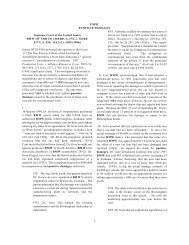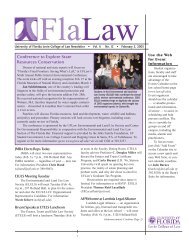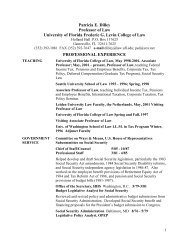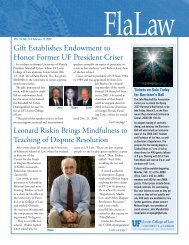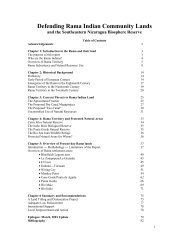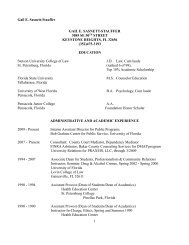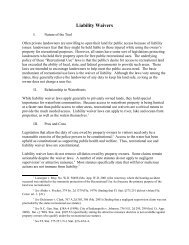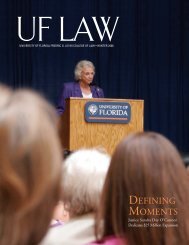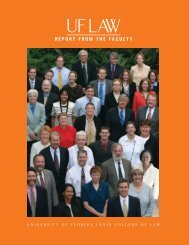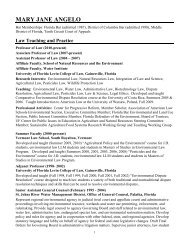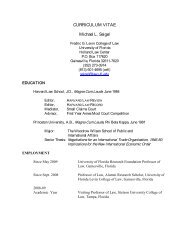Download Magazine - Levin College of Law - University of Florida
Download Magazine - Levin College of Law - University of Florida
Download Magazine - Levin College of Law - University of Florida
Create successful ePaper yourself
Turn your PDF publications into a flip-book with our unique Google optimized e-Paper software.
DAVID GRUNFELD/THE TIMES-PICAYUNEPerhaps no city stands out more vividlyas an example <strong>of</strong> this than New Orleans. Forcenturies considered the South’s most elegantand prosperous city, New Orleans had fallenon hard times by the time Hurricane Katrinaplowed through in 2005. Already adrift inurban blight before the storm, New Orleansfound herself choking on it afterwards.“Before joining NORA, ‘blight’ wasmerely a legal concept to me — somethingthat I recalled talking about in Pr<strong>of</strong>essorHunt’s preservation law seminar, Pr<strong>of</strong>essorPerea’s constitutional law class or pr<strong>of</strong>essorsNicholas or Juergensmeyer’s land use classwhile studying eminent domain cases,” saidJohn T. Marshall (JD 97), a project managerfor the New Orleans Redevelopment Authority(NORA). “That perception changedwhen I joined NORA. New Orleans is a city<strong>of</strong> almost incomparable historic beauty andcharm, but it has suffered from nearly a halfcentury<strong>of</strong> population loss — and, as familieshave moved away or people have passedaway, increasing numbers <strong>of</strong> homes have becomeforgotten.”NORA, formerly called the CommunityImprovement Agency, was created by statelaw in 1968 to “eliminate and prevent thespread <strong>of</strong> slums and blight.” Its principallegal tool to accomplish this is acquisition<strong>of</strong> abandoned and blighted properties usingeminent domain — a process called expropriation.Historically under-funded and politicallytroubled, NORA played only a minor role inNew Orleans’ early redevelopment plans, butin response to the vast devastation wroughtby hurricanes Katrina and Rita in 2005, thecity government breathed new life into thetiny agency in early 2007. Money was infusedinto the organization, its governingboard was expanded and the state legislaturewas pressed by the city to pass laws increasingthe agency’s ability to assemble land.For Marshall, NORA’s expansion wouldcreate an opportunity to use his educationand legal skills to help the city in its redevelopmentefforts, but his career path to NORAisn’t one he anticipated. After graduatingfrom the <strong>Levin</strong> <strong>College</strong> <strong>of</strong> <strong>Law</strong> with honorsin 1997, he clerked with U.S. MagistrateJudge Elizabeth A. Jenkins (JD 76) <strong>of</strong> theU.S. District Court for the Middle District<strong>of</strong> <strong>Florida</strong> in Tampa, Fla. In 1999, Marshalljoined the Holland & Knight firm as an associatein its Tampa <strong>of</strong>fice, where he gainedexperience working with local governmentsand businesses on zoning and growth managementissues. He was promoted to partnerin 2006.In September <strong>of</strong> 2007, Marshall was one<strong>of</strong> 25 mid-career pr<strong>of</strong>essionals awarded aRockefeller Foundation Fellowship in conjunctionwith the <strong>University</strong> <strong>of</strong> Pennsylvania’sCenter for Urban Redevelopment Excellence(CUREx). As part <strong>of</strong> his fellowship,Marshall, along with two other fellows, wasselected to work for NORA, an agency thefoundation had identified as a Gulf Coast entitywhose work it wished to support. Marshall’sfellowship is funded through March<strong>of</strong> 2010.“Urban redevelopment work is fascinatingbecause it draws on so many differentdisciplines, like tax law, property law, constitutionallaw, land use and zoning law,” Marshallsaid. “There’s no question in my mindthat I would not have received the RockefellerFoundation fellowship and this opportunityto serve in New Orleans were it not formy pr<strong>of</strong>essors at UF <strong>Law</strong> and my mentors atHolland & Knight, because they taught methat revitalizing cities presents many hiddenchallenges and obstacles beyond designing amore attractive streetscape.”AFTER THE STORMIn 2000, the U.S. Census reported 27,000abandoned properties in New Orleans. In theaftermath <strong>of</strong> Katrina that number balloonedto nearly 72,000 according to Greater NewOrleans Community Data Center estimates.Reasons vary for why properties in thecity were abandoned. For many, back taxesowed on the property amounted to more thanits market value. Others were abandoned afterhurricane storm damage. Still other properties,passed down through the generationswithout the benefit <strong>of</strong> formal deed transfers,are mired in convoluted questions <strong>of</strong> inheritancewhere many heirs — <strong>of</strong>ten the grandchildrenor great-grandchildren <strong>of</strong> a deceasedowner <strong>of</strong> record — may have a claim but nonehave maintained the property taxes. Theseabandoned properties pose serious health andsafety threats to New Orleans’ residents andcause property values to sink.Desperate to save itself from drowningin debt and squalor, the City <strong>of</strong> New Orleansexpanded use <strong>of</strong> eminent domain to seize andrehabilitate abandoned and blighted properties.The city’s goal was to wield its eminentdomain powers through NORA to clean upthe city, build new homes for its returningDiaspora and jump-start the city’s economicredevelopment by returning real estate tocommerce. Marshall joined NORA just as theagency ramped up its expropriation efforts.“The city saw that NORA would haveto play an important role in addressing thecity’s blight problem,” said Marshall. “Theconsensus among policymakers and localelected <strong>of</strong>ficials was that NORA’s expropriationpowers could serve as a critical tool tocombat urban blight and could dramaticallyincrease the number <strong>of</strong> public health andsafety expropriations.”Marshall added that before NORA expropriatesa property, the agency first <strong>of</strong>fersto purchase the property from the owner <strong>of</strong>record for its appraised value. This involvesproviding the last known owner, or the owner’sheirs, with notice <strong>of</strong> NORA’s intent totake the property.“The process also includes filing a civilaction in the state’s trial courts and, ultimately,trying the case before the court,” Marshallsaid. “The interests <strong>of</strong> the owners and potentialheirs are represented at trial by a courtappointedattorney or ‘curator.’ ”John T. Marshall(right) speaks withGentilly-PontchartrainNeighborhood Associationmembers EmanuelEsteves Jr. (center) andVictor Gordon (left) infront <strong>of</strong> the GentillyWoods Shopping Centerin March, 2008.FALL 2008 31




